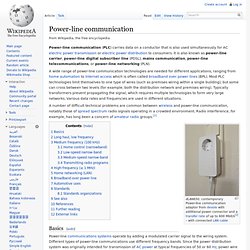

IEEE P1901. The IEEE Std 1901-2010 is a standard for high speed (up to 500 Mbit/s at the physical layer) communication devices via electric power lines, often called broadband over power lines (BPL). The standard uses transmission frequencies below 100 MHz. This standard is usable by all classes of BPL devices, including BPL devices used for the connection (<1500m to the premise) to Internet access services as well as BPL devices used within buildings for local area networks, smart energy applications, transportation platforms (vehicle), and other data distribution applications (<100m between devices).[1] The IEEE Std 1901-2010 standard replaced a dozen previous powerline specifications.
Power line communication. Power-line communication (PLC) carries data on a conductor that is also used simultaneously for AC electric power transmission or electric power distribution to consumers.

It is also known as power-line carrier, power-line digital subscriber line (PDSL), mains communication, power-line telecommunications, or power-line networking (PLN). A wide range of power-line communication technologies are needed for different applications, ranging from home automation to Internet access which is often called broadband over power lines (BPL). Most PLC technologies limit themselves to one type of wires (such as premises wiring within a single building), but some can cross between two levels (for example, both the distribution network and premises wiring). How To Kill The Home Networking Industry - How We See CE - Blog.